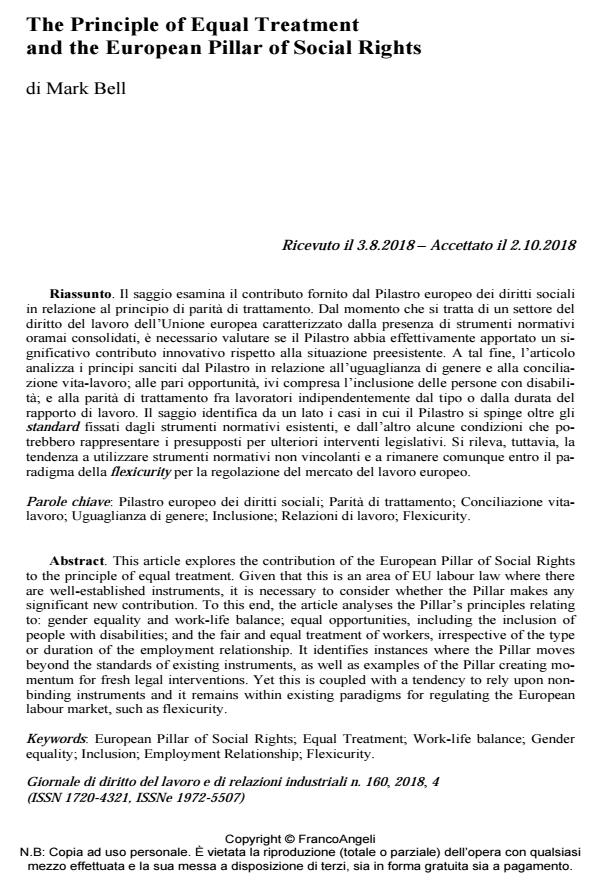The Principle of Equal Treatment and the European Pillar of Social Rights
Titolo Rivista GIORNALE DI DIRITTO DEL LAVORO E DI RELAZIONI INDUSTRIALI
Autori/Curatori Mark Bell
Anno di pubblicazione 2019 Fascicolo 2018/160
Lingua Inglese Numero pagine 28 P. 783-810 Dimensione file 303 KB
DOI 10.3280/GDL2018-160005
Il DOI è il codice a barre della proprietà intellettuale: per saperne di più
clicca qui
Qui sotto puoi vedere in anteprima la prima pagina di questo articolo.
Se questo articolo ti interessa, lo puoi acquistare (e scaricare in formato pdf) seguendo le facili indicazioni per acquistare il download credit. Acquista Download Credits per scaricare questo Articolo in formato PDF

FrancoAngeli è membro della Publishers International Linking Association, Inc (PILA)associazione indipendente e non profit per facilitare (attraverso i servizi tecnologici implementati da CrossRef.org) l’accesso degli studiosi ai contenuti digitali nelle pubblicazioni professionali e scientifiche
This article explores the contribution of the European Pillar of Social Rights to the principle of equal treatment. Given that this is an area of EU labour law where there are well-established instruments, it is necessary to consider whether the Pillar makes any significant new contribution. To this end, the article analyses the Pillar’s principles relating to: gender equality and work-life balance; equal opportunities, including the inclusion of people with disabilities; and the fair and equal treatment of workers, irrespective of the type or duration of the employment relationship. It identifies instances where the Pillar moves beyond the standards of existing instruments, as well as examples of the Pillar creating momentum for fresh legal interventions. Yet this is coupled with a tendency to rely upon non-binding instruments and it remains within existing paradigms for regulating the European labour market, such as fle-xicurity.
Il saggio esamina il contributo fornito dal Pilastro europeo dei diritti sociali in relazione al principio di parità di trattamento. Dal momento che si tratta di un settore del diritto del lavoro dell’Unione europea caratterizzato dalla presenza di strumenti normativi oramai consolidati, è necessario valutare se il Pilastro abbia effettivamente apportato un significativo contributo innovativo rispetto alla situazione preesistente. A tal fine, l’articolo analizza i principi sanciti dal Pilastro in relazione all’uguaglianza di genere e alla conciliazione vita-lavoro; alle pari opportunità, ivi compresa l’inclusione delle persone con disabilità; e alla parità di trattamento fra lavoratori indipendentemente dal tipo o dalla durata del rapporto di lavoro. Il saggio identifica da un lato i casi in cui il Pilastro si spinge oltre gli standard fissati dagli strumenti normativi esistenti, e dall’altro alcune condizioni che potrebbero rappresentare i presupposti per ulteriori interventi legislativi. Si rileva, tuttavia, la tendenza a utilizzare strumenti normativi non vincolanti e a rimanere comunque entro il paradigma della flexicurity per la regolazione del mercato del lavoro europeo.
Parole chiave:Pilastro europeo dei diritti sociali; Parità di trattamento; Conciliazione vita-lavoro; Uguaglianza di genere; Inclusione; Relazioni di lavoro; Flexicurity.
- A New Gender Equality Contract for Europe Eugenia Caracciolo di Torella, pp.65 (ISBN:978-3-031-59992-7)
Mark Bell, The Principle of Equal Treatment and the European Pillar of Social Rights in "GIORNALE DI DIRITTO DEL LAVORO E DI RELAZIONI INDUSTRIALI " 160/2018, pp 783-810, DOI: 10.3280/GDL2018-160005